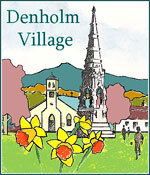The village remained an agricultural community until the end of the 18th century when the stocking industry was introduced. It prospered and by 1837 it is recorded that most of the inhabitants are stocking makers and others engaged in rural affairs. In 1844 there were 87 stocking frames in Denholm.
The machines were set-up in the cottages at the windows in order to get the best light. Many cottages around the green were built or rebuilt with the flourishing of the new industry. Some of these cottages, or stocking shops, are still standing part of Leyden's Cottage, Rosebank, and the rear of the Fox and Hounds Inn and the rear of 5 Main Street. There was also a stocking shop on the site of Swiss Villa in the Cannon Gate. The Old Mill at West End, now converted into a private house, was once a three storey stocking mill. There was also a two storey mill, no longer standing, behind Sunny Bank in Leyden's Road.
The owners of these businesses used to sell their wares all over the North of England and South of Scotland, from Newcastle to Glasgow and Edinburgh. The first hosiery manufacturer in Denholm is thought to have been Thomas Colledge. His apprentice, Andrew Scott, set up his own business and we are told that his supplies were never able to meet the demand of his Glasgow market. When he advised his customers there that he intended to call on them they would travel up to 20 miles out of the city to meet him and bid against each other for his goods. He lived in Hazeldean at the East End.
The firm of Dickson and Beattie was set-up in 1793. Their scouring house was the cottage where John Leyden was born. But in 1803 the family moved to Hawick where it was to become Dickson and Laing. From now on the Denholm enterprises were dwarfed by the large Hawick factories. Denholm remained a village and Hawick soon became a large manufacturing town.
Apart from George Hardy, who at one time employed 20 hands, most of the 19th century concerns were very small, many of them one-man businesses. Hosiers and stocking makers recorded in the 1835 Deed of Excambion are James and Andrew Scott, William Barry, Robert Turnbull, Thomas Scott, George Hardy, Robert Nichol, William Leyden, James Scott, John Turnbull, Robert Scott and George Beattie. Also known from other sources are Thomas Oliver, Robert Forsyth, Thomas Riddell, James little, who lived in the house where the entrance to the school playground is now, William Little in a cottage where the wall outside Denholm House is now, William Percival Scott in Leyden's Road and William Robson who built Rose Bank Cottage and stocking shop.
The census of 1861 records 32 stocking makers in Denholm. Latterly they were almost entirely dependent on the Hawick manufacturers for work. A cart used to come from Hawick once a week bringing out the yarn and taking back the knitted garments. It stopped at Town Head, at the West end of the village. Eventually even these weekly visits were discontinued and the stocking makers took their work into Hawick each weekend themselves, often walking there and back and getting their ‘count,’ or wages, on the Saturday. The very last of the village hosiers were Willie Cook of Denholm and John Stafford of Hawick, who died in 1909 and 1910.
Stocking Mill (Westgate)
This Stocking Mill in the village dates from the late 18th century.
A three-storey, 2- by 6-bay rubble building with small windows for individual stocking frames in the upper floors was later converted to a warehouse by the insertion of a door and wall crane at first-floor level and is now a private house.
This mill represents an interim stage between cottage industry and the full-blown factory production of the Hawick mills.

